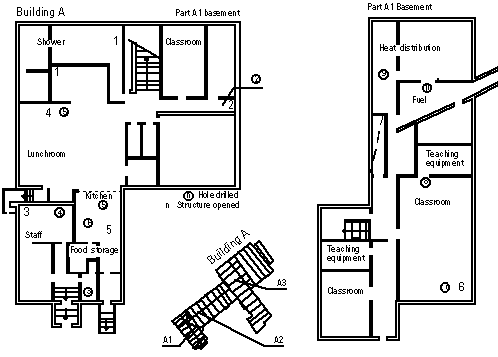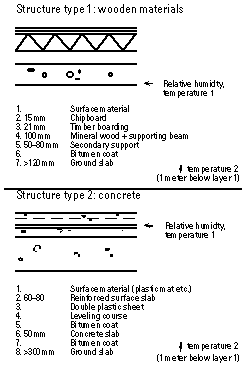|
|
Environmental Health Perspectives Volume 107, Supplement 3,
June 1999
An Approach to Management of Critical Indoor Air Problems in School BuildingsUlla Haverinen,1 Tuula Husman,1 Mika Toivola,1 Jommi Suonketo,2 Matti Pentti,2 Ralf Lindberg,2 Jouni Leinonen,3 Anne Hyvärinen,1 Teija Meklin,1 and Aino Nevalainen1 1National Public Health Institute, Laboratory of Environmental Microbiology and Unit of Epidemiology, Kuopio, Finland; 2Tampere University of Technology, Laboratory of Structural Engineering, Tampere, Finland; 3Korpilahti Town, Korpilahti, Finland Abstract This study was conducted in a school center that had been the focus of intense public concern over 2 years because of suspected mold and health problems. Because several attempts to find solutions to the problem within the community were not satisfactory, outside specialists were needed for support in solving the problem. The study group consisted of experts in civil engineering, indoor mycology, and epidemiology. The studies were conducted in close cooperation with the city administration. Structures at risk were opened, moisture and temperature were measured, and the causes of damage were analyzed. Microbial samples were taken from the air, surfaces, and materials. Health questionnaires were sent to the schoolchildren and personnel. Information on the measurements and their results was released regularly to school employees, students and their parents, and to the media. Repairs were designed on the basis of this information. Moisture damage was caused mainly by difficult moisture conditions at the building site, poor ventilation, and water leaks. Fungal genera (concentrations <200 colony-forming units (cfu)/m3, <3000 cfu/cm2) typical to buildings with mold problems (e.g., Aspergillus versicolor, Eurotium) were collected from the indoor air and surfaces of the school buildings. Where moisture-prone structures were identified and visible signs of damage or elevated moisture content were recorded, the numbers of microbes also were high; thus microbial results from material samples supported the conclusions made in the structural studies. Several irritative and recurrent symptoms were common among the upper secondary and high school students. The prevalence of asthma was high (13%) among the upper secondary school students. During the last 4 years, the incidence of asthma was 3-fold that of the previous 4-year period. Key words: asthma, health effects, moisture damages, mold, questionnaire, respiratory symptoms. -- Environ Health Perspect 107(suppl 3):509-514 (1999). This article is based on a presentation at the International Conference on Indoor Mold and Children held 21-24 April 1998 in Alexandria, Virginia. Indoor air problems caused by the moisture and mold occur not only in residential but also in public buildings (1). Microbial growth and building moisture is associated with adverse health effects such as respiratory symptoms and the increased prevalence of respiratory infections (2). In many cases, however, there is not sufficient local experience to recognize a building-associated disease, to determine the documentation needed for correct conclusions, and to manage the overall case. This study concerns a school center in a small town in southern Finland, where the occupants had symptoms associated with the buildings. As experience with indoor air problems was insufficient among the health authorities, the town administration turned to a group of outside experts. The aims of the study were to assess the moisture and microbial status of the school buildings and the health situation of the school occupants, and to establish a strategy to deal with this type of problem. We report an approach to managing indoor air problems associated with moisture and mold in a practical situation. The investigations and analyses required to obtain the necessary information, as well as the essential findings, are briefly described.
Material and MethodsThe school center contained three buildings. The upper secondary and high schools were located mainly in building complex A, called stone school, which has three parts: part A1 (built in 1954), part A2 (built in 1951), and part A3 (built in 1961). Building B, the elementary school, is a brick building built in 1955. In addition, the upper secondary and high schools use facilities from building C--the wooden school, a log building constructed in 1888. The study included structural, microbial, and health effects studies. Each part of the study was supervised by experts in the field. All studies were done in close cooperation with the town administration. The studies advanced hierarchically and the results of each step were discussed in meetings. The overall design of the study is presented in Figure 1.
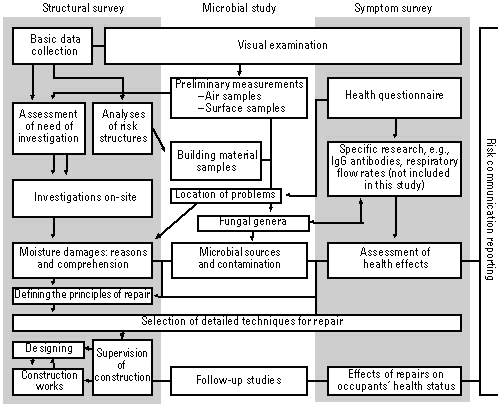
Figure 1. Flow chart of the study design. Structural Survey All available building documents, e.g., drawings, structural designs, and information about repair history of the buildings, were collected and the buildings were first examined visually (3). The most serious problems were registered in the base floors of the buildings. For on-site investigations, 20-mm holes were drilled throughout ground slab at 15 sites and through the wall structures at 2 sites (Figure 2). Building material layers and thickness were observed from cuttings and drill ability. If the drilling was successful, the holes were obstructed and the conditions were allowed to stabilize before moisture and temperature was measured. A bar was driven into the holes until the resistance became too great, to define soil type and moisture condition. To obtain more information, the structures were later opened (e.g., areas of approximately 0.2-1 m2 were dismantled at 10 sites) (Figure 2). The ventilation in the crawl spaces under the ground floors was tested with a thermohygrograph. Figure 2. Site map of structural measures. See Table 1. Microbial Study Two percent malt extract and dichloranglyserol-18 agars were used for mesophilic fungi, and tryptone glucose yeast agar was used for bacteria. After 7 days of incubation at 25°C, the colonies were counted and the fungal flora was determined. The bacterial samples were incubated at 20°C for 14 days. Concentrations of viable fungi were regarded as elevated according to the guidelines given by Finnish Ministry of Social Affairs and Health (5): air samples > 100 colony-forming units (cfu)/m3 if the finding was supported by the unusual genera, surface samples > 1,000 cfu/cm2, and material samples > 10,000 cfu/g. The fungal colonies were identified morphologically. The occurrence of the genera, which indicated moisture as well as an unusual rank order of the genera (4,6), was recorded. Surveyors were advised to wear respiration filters and protective clothing during those stages of the investigations when mold or dusty materials were handled. Problematic rooms were not used and were isolated before they were repaired to avoid air change between other facilities. Some repairs were performed using dust techniques similar to those used in asbestos abatement. Recommendations were made for cleaning of the rooms (working methods, chemical types, etc.) after the removal of materials contaminated by microbes. These included wiping all surfaces and disinfecting materials prone to contamination, e.g., chlorine treatment of concrete (7). In addition, to protect wooden parts that could not be replaced, disinfection with boron substances was recommended. Symptom Survey The questionnaires used were developed on the basis of earlier studies on air pollution and respiratory health (8,9); they had been used for mold-related designs in several studies (10,11). The questionnaire for students included 44 questions on respiratory and general health, and allergies of the subject; 12 questions on housing and sociodemographics of the families; and 16 questions about the school. Asthma was included: Has a doctor ever said that you have/your child has asthma? (No/Yes, diagnosed year 19__.) The questionnaire for the employees was more specific and consisted of a section on working conditions with 31 questions and a section on health information with 91 questions. In the section on working conditions, there were questions about the work, employee position and length of service, working motivation and atmosphere, and causes and sites of inconveniences experienced by the work. The section on health information documented symptoms and diseases such as respiratory infections and factors that were related to them according to the respondent. General information, such as housing, living habits (smoking, free-time activities), and education, was also recorded in this section of the employee questionnaire. The extent of symptoms of the students and personnel
working in buildings A and C were compared with those in
building B, which was assumed to be a nondamaged reference
building. The data were analyzed with the SPSS program (SPSS
6.0 for Windows) by using
Risk Communication ResultsCauses and Comprehension of Moisture Damages Various structure layers were observed from different sites in the stone school (A) and assumed to be results of earlier repairs. In general, structures could be categorized into two types: structures with layers of wooden materials and structures consisting mainly of concrete materials (Figure 3). Results from the structural measurements in the building are presented in Table 1. Moisture conditions in the site were problematic. The base floor was built mostly on a thick level of capillary clay, partly without capillary break. A groundwater monitoring tube showed that the groundwater was at the level of the concrete slab lower surface. Before the underdrain, rainwater sewer, and cellar walls outside the water barrier were built in the fall of 1995 as part of the repair process, surface water could seep under the building. Changes in this type of soil occur slowly, but it may also be impossible to stop the water penetration. All wooden structures (structure type 1) of the floor of the basement store had to be replaced by structures with better moisture resistance (14) and with surfaces through which possible moisture would evaporate. 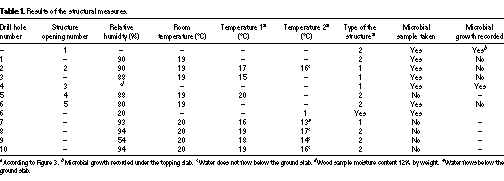
In the elementary school (B) basement classroom, damaged floor structures were observed. Although the measurements did not indicate unusual moisture, the structure was opened. Under the chipboard layer an area of approximately 1 square meter was filled with water from a leak in the plumbing. Microbial Status In some surface samples of the stone school (A), concentrations were unusually high, and the genera present, e.g. A. versicolor, indicated problems with moisture and mold (6). A. versicolor, which is often associated with damp buildings, was the most common genus detected in various damaged samples. The concentrations of A. versicolor are therefore presented here as an example (Table 2). 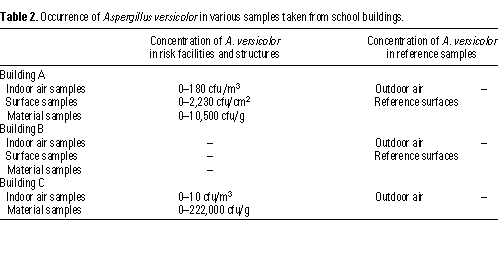 In general, microbial results from material samples supported the conclusions made in the structural studies (Table 3). For example, high concentrations of fungi detected from the materials from wooden floor structures of the stone school (A) (sample 1) indicated a high moisture content and the decision was made to remove the structures. Microbial concentrations in the concrete floor structures were relatively small (sample 2). Sample 3 from the classroom in the elementary school (B) had high concentrations of fungi. In addition to rot fungi, mold was also found in the wooden school (C) structures (sample 4).  Health Effects Some results are reported in Table 4. Several irritative and nonspecific symptoms such as nasal congestion, rhinitis, phlegm, shortness of breath, eye irritation, hoarseness, and fatigue, during the previous year of the study, were significantly more common among the upper secondary and high school students than among the elementary school children. After adjusting for age, sex, smoking, and atopy, the observed differences among the student groups remained significant in nasal congestion, rhinitis, phlegm, hoarseness, and fatigue (odds ratios not shown). The exposed students also had had more long-term and repetitive flu, cough, and eye symptoms. Asthma symptoms were common among upper secondary and high school students. The prevalence of asthma among the upper secondary school students was high (13%) compared to recently reported average prevalence of asthma among this age group (4-7% in different in regions of Finland) (16). During the previous 4 years, 18 new cases of asthma were diagnosed, whereas in earlier 4-year periods 4-6 cases were diagnosed annually (Table 4). Use of health services and medication because of asthma was not any higher in this group than among youth of the same age on average. DiscussionThe types of moisture damages can be divided into four categories:
Success in making correct conclusions on the basis of the structural survey depends on the surveyor's expertise. In the case of moisture problems, knowledge of the structure's moisture physics is essential. Buildings must be examined systematically, and observations may need support from measurements and other study methods. It is important to realize that even if damage is small from a structural point of view, it may still lead to microbial growth and cause adverse health effects. The mitigation of mold problems is therefore multidimensional. In the microbial study, air and surface samples provided basic data for the structural survey and helped locate the moisture sites. The conclusions made on the basis of the structural survey were supported by the microbiological results of the material samples, which verified the presence of microbial growth in the sites considered high risk for moisture damage from a technical point of view. It was informative to carry out these two studies in parallel. Microbial growth in structures is caused by excessive moisture. By understanding the structure's moisture physics and microbiology, the origin of the problem often can be found and removed. Microbial results vary with time, place, circumstances of sampling, and methods used, and the determinants of total exposure to microbes are poorly known so far. Viable or culturable microorganisms comprise 1-10% of the total number of microbial cells; on the basis of our present understanding, the numbers and genera of viable microorganisms reflect the microbial status of the building and are satisfactory surrogates of the exposure once the sampling has been properly focused (4,6,15). A microbial or structural study alone may not lead to independent conclusions, but both are needed in evaluating the situation. Information obtained from the questionnaire about the facilities where the users had experienced problems helped to identify the structural problems. The unusually high prevalence of respiratory symptoms, their association with school buildings A and C, and the increased incidence of asthma indicated that a comprehensive investigation of the condition of the buildings was necessary. The prevalence of asthma among the upper secondary school students was twice that of the general population prevalence of asthma among teenagers (8,16). Among the students who returned the questionnaire, in the previous 4 years, the asthma incidence was 3-fold as compared to earlier 4-year periods. Use of health services and medication because of asthma was not higher in these teenagers than in other teenagers on average, indicating relatively moderate or early-phase illnesses. Some moisture faults were also found in the elementary school (B), which was originally assumed to be a nondamaged reference building and was therefore studied only briefly. Naturally, the minor damages found may also have caused exposure and symptoms of the occupants. However, significant differences were found among the health status of the occupants of buildings A and C, compared to those among occupants of this building (B). Had the reference building been undamaged, the observed differences in health status of the student groups may have been even bigger. On the other hand, the degree of the damage depends on several variables such as age, use, maintenance, and repair of the building. Thus, a completely undamaged building may be as abstract a concept as is a totally healthy human being. The exposure in home environment may play a role in the development of respiratory symptoms and asthma, but in this study it was not possible to assess the domestic situation of each participant. It could be assumed that the possible exposure in the home environment was equally distributed among the occupants of the different buildings A, B, and C. The reporting of symptoms associated with the buildings may have increased as a result of common awareness and publicity about the study. Information collected in self-administered questionnaires is not always as valid as that collected in clinical studies (17,18). The diagnoses of asthma were made by a physician and can be regarded as objective findings. Symptoms associated with mold exposure are otherwise nonspecific and difficult to measure. On the other hand, a questionnaire study is easy to carry out and cost effective, and provides direct information from the occupants. Special attention was paid to the communication with the occupants of the buildings during the study. Releasing information about the purpose of the studies, the measurements, and their results to the employees, authorities, schoolchildren, parents, and the media helped to open the situation to constructive discussion. Our experience confirmed the importance of public meetings to keep the atmosphere open. Although the condition of residential buildings is ultimately the owner's responsibility, the distribution of risk is more complicated in public buildings. Situations can result in which the responsibility is not clear but shared among different parties involved. To remedy this kind of situation, it may be necessary to use outside consultants. The overall purpose of the study was to find a useful management strategy to solve the critical indoor air situation. It was focused not only on supporting the repair of damages but also on carefully analyzing the original cause of the problem to understand the effects. Although it was not possible for each part of the study to cover the problem in its entirety, the different parts complemented one another. To connect the studies in order to construct a systems approach and to draw conclusions for use by the town administration, it was important to combine broad expertise in each part and link them by effective cooperation. Follow-up studies will be conducted to analyze construction solutions and their effects on moisture resistance in the structure. A microbial exposure follow-up will be done, and the questionnaire study will be repeated after the repairs are completed. The follow-up study will bring further information on the suggested connection between exposure and health findings. Thus it will be possible to assess the effect of elimination of the exposure on the decrease of the illness. ConclusionsIn buildings A and C, several serious moisture problems were identified. The conclusions based on the structural survey were supported by the results of the microbial study, as the sites of moisture damage proved to be sources of unusual microbial growth. Respiratory symptoms and general symptoms were more common among the students occupying these buildings. Each part of the study was needed in order to analyze and link together the reason for the moisture damage, the microbial status of the buildings, and the health disorders of the occupants. The multidisciplinary approach appeared to be a fruitful way to solve a critical situation such as this. REFERENCES AND NOTES 1. Nevalainen A, Partanen P, Jääskeläinen E, Hyvärinen A, Koskinen O, Meklin T, Vahteristo M, Koivisto J, Husman T. Prevalence of moisture problems in Finnish houses. Indoor Air 4:45-49 (1998). 2. Husman H. Health effects of indoor-air microorganisms. Scand J Work Environ Health 22:5-13 (1996). 3. Environment Guide 28. How to investigate the state of a building damaged by humidity and mould [in Finnish, abstract in English]. Helsinki:Ministry of Environment, Housing and Building Department, 1997. 4. Hyvärinen A, Reponen T, Husman T, Ruuskanen J, Nevalainen A. Characterizing mould problem buildings--concentrations and flora of viable fungi. Indoor Air 3:337-343 (1993). 5. Guidelines for Indoor Air Quality [in Finnish]. Helsinki:Ministry of Social Affairs and Health, 1997. 6. Samson RA, Flannigan B, Flannigan ME, Verhoeff AP, Adan OCG, Hoekstra ES. Health implications of fungi in indoor environments. Air Quality Monogr 2:531-538 (1994). 7. Flannigan B, Morey PR. Control of moisture problems affecting biological indoor air quality. ISIAQ-guideline: Task Force 1. Ottawa:International Society of Indoor Air Quality and Climate, 1996. 8. Timonen KL, Pekkanen J, Korppi M, Vahteristo M, Salonen RO. Prevalence and characteristics of children with chronic respiratory symptoms in eastern Finland. Eur Respir J 8:1155-1160 (1995). 9. Husman T. Association between ambient air pollution and respiratory symptoms and diseases in four industrial cities in southwestern Finland [in Finnish, abstract in English]. MD Dissertation. Helsinki:University of Helsinki, 1995. 10. Taskinen T, Meklin T, Nousiainen M, Husman T, Nevalainen A, Korppi M. Moisture and mould problems in schools and respiratory manifestation in schoolchildren: clinical and skin test findings. Acta Pediatr 86:1181-1187 (1997). 11. Koskinen O, Husman T, Hyvärinen A, Reponen T, Nevalainen A. Respiratory symptoms and infections among children in a day-care center with mold problems. Indoor Air 5:3-9 (1995). 12. SPSS Inc. SPSS-XTM User's Guide, 3rd Edition. Chicago:SPSS Inc, 1988;429-444, 849-870, 969-971. 13. Viitanen H. Factors affecting the development of mould and brown rot decay in wooden material and wooden structures. PhD Dissertation. Uppsala, Sweden:The Swedish University of Agricultural Sciences, Department of Forest Products, 1996. 14. Tulla K. The moisture contents of the wooden structures in contact with the foundation [in Finnish, abstract in English]. Espoo, Finland:The Technical Research Center of Finland, Building Technology, 1987;769. 15. Meklin T, Taskinen T, Nevalainen A. Microbial characterization of four school buildings. Proceedings of the 7th International Conference on Indoor Air Quality and Climate, 21-26 July, Nagoya, Japan 2:1083-1098 (1996). 16. Pekkanen J, Remes ST, Husman T, Lindberg M, Kajosaari M, Koivikko A, Soininen L. Prevalence of asthma symptoms in video and written questionnaires among children in four regions of Finland. Eur Respir J 10:1787-1794 (1997). 17. Brunekreef B. Association between questionnaire reports of home dampness and childhood respiratory symptoms. Sci Total Environ 127:79-89 (1992). 18. Dales RE, Schweitzer I, Bartlett S, Raizenne M, Burnett R. Reproducibility of respiratory symptoms and reported home dampness and molds using a self-administered questionnaire. Indoor Air 4:2-7 (1994).
Last Updated: May 18, 1999 |
